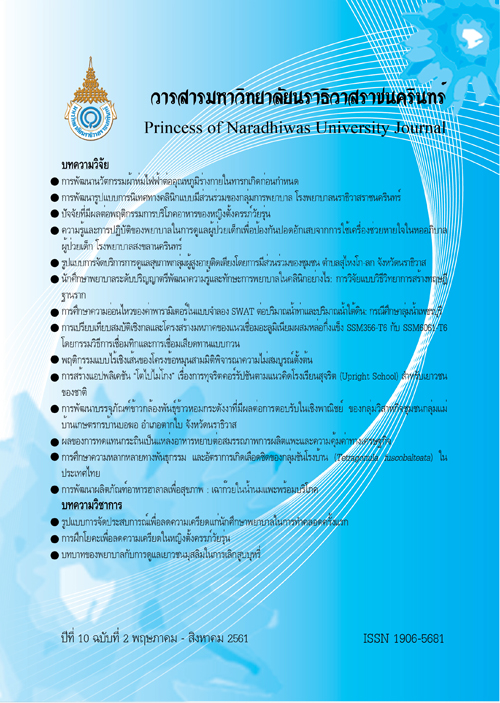Development of Halal Food for Health: Ready to Eat Chao Kuai in Goat Milk
Keywords:
Chao Kuai, Gelatin, Halal, Goat MilkAbstract
The objective of this study was to develop a mixture of goat milk with Chao Kuai (grass jelly) from
different providers and investigate: 1) quality of Chao Kuai production in local market, 2) quantity of fish
gelatin added in Chao Kuai to define a standard formula, and 3) quantity of sugar in sweetened formula
with pasteurized goat milk. The result indicated that an addition of 1% fish gelatin in Chao Kuai received
the highest sensory evaluation score of overall liking (7.65±0.12 points). More gelatin resulted in less water
release from gel in Chao Kuai and, therefore, a longer storage time (p<0.05). Addition of 12% sugar content
in goat milk received the highest sensory evaluation score of odor and taste as 7.60±0.66 and 7.55±0.77
points with statistically significant (p<0.05). Chao Kuai in goat milk included protein, fat, carbohydrate, ash,
fiber and moisture as 0.17%±0.13 0.02%±0.15 45.62%±0.21 10.20%±0.34 0.03%±0.10 and 43.96±0.42,
respectively. The analysis of protein, fat, lactose and total solid in goat milk pasteurized was shown
as 3.30±0.05, 3.68±0.10, 6.47±0.06 and 12.15±0.08, respectively that met the Thai Industrial standard
(TIS: ICS 67.10.10). The shelf life of products determined by growth on general TPC, yeast and mold, as well
as E.coli was stored for 8 days at 5±1°C. Those microorganisms did not exceed the standard.
References
AOAC. (2000). Official Method of Analysis of AOAC International. (17th ed.). Virginia: The Association of Official Analytical Chemists.
BAM. (2001). Bacteriological Analytical Manual - Chapter 3: Aerobic Plate Count. Retrieved from http://www.fda.gov.com.
BAM. (2002). Bacteriological Analytical Manual - Chapter 4: Enumeration of Escherichia coli and the coliform
bacteria. Retrieved from http:// www.fda.gov.com.
Cho, S. Y., & Rhee, C. (2004). Mechanical properties and water vapor permeability of edible films made from
fractionated soy proteins with ultrafiltration. Lebensmittel – Wissenschaft und – Technologie, 37, 833 - 839.
Farrell Jr., H.M., Jimenez-Flores, R., Bleck, G.T., Brown, E.M., Butler, J.E., Creamer, L.K., ..., Swaisgood, H.E.
(2004). Nomenclature of the proteins of cows’ milk--sixth revision. Journal of Dairy Science, 87(6), 1641-1674.
Glicksman, M. (1969). Gum Technology in the Food Industry. Academic Press, New York and London.
Kamiñski, S., Cieoeliñska, A. & Kostyra, E. (2007). Polymorphism of bovine beta-casein and its potential effect on human health. Journal of Applied Genetics, 48, 189-198.
Montilla, A., Balcones, E., Olano, A., & Calvo, M. M. (1995). Influence of heat treatments on Whey protein denaturation and rennet clotting properties of cow, s and goat, s milk. Journal of Agricultural and Food Chemistry, 43(7), 1908-1911. doi: 10.1021/jfooo55a028.
Polangga, A., Rattanapiset, W., & Songsrirote, K. (2013). Antioxidant activities, and phenolic and flavonoid contents of extracts from Mesona chinensis and Cissampelos pareira L. Journal of Science and Technology, 33(3), 224-232.
Pornchaloempong, P. and Ratanapanon, N. (n.d.). Maillard Reaction. Retrieved from http://www.Food network solution.com/wiki/word/0397/maillard-reaction. (in Thai)
Rawdkuen, S. (2013). Gelatin: Extraction and utilization. Retrieved from http://www.Mfu.ac.th/school/agro 2012/events/482. (in Thai)
Ruengdech, A. (2010). Product Development of Chaokuai with Jelly Mushroom Drink. Rajamangala University of Technology Krungthep. (in Thai)
Somboon. N. (2012). Properties of Agar and Fish Gelatin Mixed Gels. Master thesis of Science on Program in Food Science and Nutrition, Pattani: Prince of Songkhla Univesity. (in Thai)
Thai Agricultural Community and Food Standard. (TACFS 6006 – 2008). Raw Goat Milk. National Bureau of Agricultural Commodity and Food Standards. Available at http://www.acfs.go.th/about.php. (February 15, 2017]) Thai Community Product Standards (TCPS 517/2005). Chao Kuai. Thai Industrial Standard Institute. Available http://app.tisi.go.th/otop/pdf_file/tcps517_47.pdf. (January 12, 2017)
Thai Industrial Standard. Fresh Milk. Thai Industrial Standard Institute. Available www.fio.co.th/p/tisi_fio/
fulltext/TIS738-2547.pdf. (January 12, 2017)
Thai Notification of the Ministry of Public Health. (2013). Milk Products. Ministry of Public Health. Available:
www.rapat.or.th/images/column_1344938304. [February 8, 2017]
Tongta, S. (2009). Resistant Starch Properties from Rice Varieties for Functional Foods. Nakhon Ratchasima:
Suranaree University of Technology. (in Thai)




